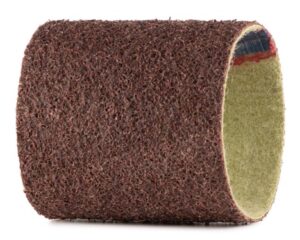What is the significance of belt grit for sanding machines?
One of the important indicators is the grain size of the belt for grinding machines. The size of the granules on the surface and the purpose of the tape depend on it. In some cases, the material is used for fine processing, in others - only for rough processing. The main selection criteria and grain size markings are described in the article.
The content of the article
What is grit?
Grit is the most important characteristic of the belt, which determines its area of application. Different characteristics have meaning:
- types of abrasive powder;
- granule size (degree of granularity);
- method of applying abrasive powder.
Belt abrasives are made based on different chemical compositions:
- Silicon carbide is a very durable powder and is therefore used for working with metal, plastic parts, painted coatings and fiberglass.
- Garnet is a natural material of high hardness, suitable for processing wood of any species.
- Ceramic abrasive is another hard powder that is used on wood materials, including to level the surface.
- Aluminum oxide is a coarse powder used in woodworking. The metal is soft, so the grains “spread” a little when heated. Thanks to this, they form new edges and work effectively even with repeated processing.

The method of applying the abrasive also matters.To cover the surface of the belt with many granules, 2 filling technologies are used:
- Open and semi-open - the grain covers approximately half the surface (within 40-60%). In this case, the tape is used only for working with soft materials. This can be wood with a high resin content, putty surface and others.
- Continuous or closed filling - in this case, the abrasive powder completely covers the surface. Such belts are used for grinding hard surfaces. It can be metal or hardwood.
Depending on the purpose for which the tape is intended, the size of the grains (granules) can be either very small (3-5 microns) or relatively large (2-3 mm). This is covered in more detail in the next section.
Grit levels
Of particular importance for grinding is the grain size, that is, the size of the abrasive granules. Based on this parameter, there are 2 types of grain size – fine and coarse. They are designated by the letter "P" and certain numbers, as described below.
Fine grit
Fine-grained tapes are used for various tasks; among representatives of this group there are 4 categories:
- From P240 to P280 – final grinding.
- From P400 to P600 – polishing of the final coating.
- P1000 – fine processing.
- From P1200 to P2500 – delicate grinding.

Coarse grain
In the group of coarse abrasives there are also 4 categories:
- Particularly large (designated in the range from P22 to P36). These belts are only suitable for rough sanding.
- Large (from P40 to P60) are belts that are used for initial sanding of wood or other materials.
- From P70 to P120 - abrasive is used for primary processing.
- From P150 to P220 – for final grinding.
When purchasing tapes of a particular grain size, you need to evaluate how suitable they are using the correspondence table. To do this, check the size, comparing it with the Russian standard according to GOST 3647-80, and, if necessary, also with European, Chinese or American standards.





